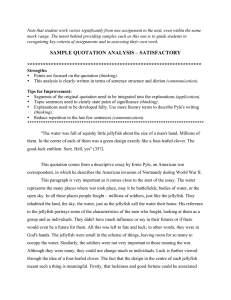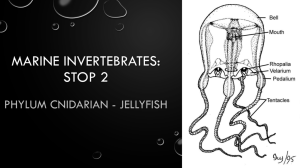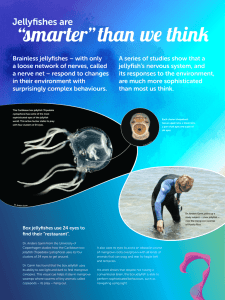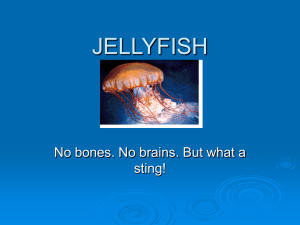9 f J reshwAter
advertisement
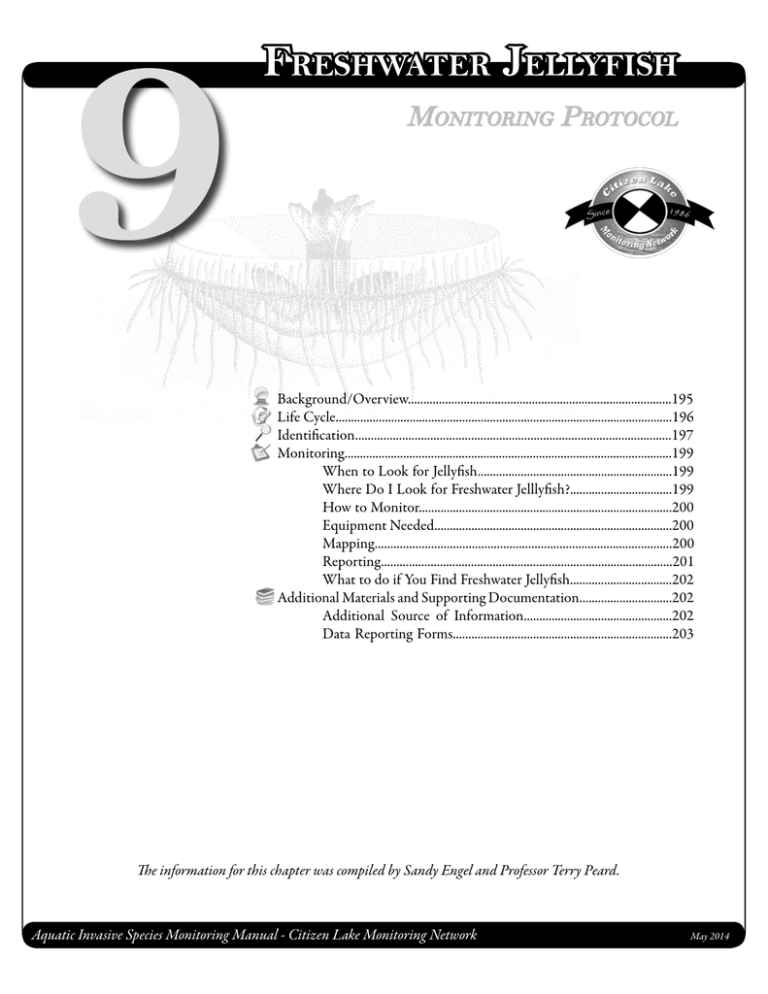
9 Freshwater Jellyfish Monitoring Protocol Background/Overview.....................................................................................195 Life Cycle.............................................................................................................196 Identification.....................................................................................................197 Monitoring..........................................................................................................199 When to Look for Jellyfish...............................................................199 Where Do I Look for Freshwater Jelllyfish?.................................199 How to Monitor..................................................................................200 Equipment Needed.............................................................................200 Mapping...............................................................................................200 Reporting..............................................................................................201 What to do if You Find Freshwater Jellyfish.................................202 Additional Materials and Supporting Documentation..............................202 Additional Source of Information................................................202 Data Reporting Forms.......................................................................203 The information for this chapter was compiled by Sandy Engel and Professor Terry Peard. Aquatic Invasive Species Monitoring Manual - Citizen Lake Monitoring Network May 2014 Northern water-milfoil turion leaves. Background/Overview The freshwater jellyfish found in Wisconsin are one of several species of Craspedacusta native to China. Two species (C. sowerbii and C. sinensis) live in the Yangtze River—the world’s third longest river and one so vast it makes the Wisconsin River seem like a trout stream! Freshwater jellyfish were first reported in North America as early as 1884. Sightings in Wisconsin date back to 1969. Much more remains to be learned about these fascinating creatures. Although they probably evolved from estuarine species, themselves descendents of ocean jellyfish, little is known about the evolution of freshwater jellyfish. That’s because jellyfish leave no fossil records. In China, male and female medusae form from spring until fall and congregate in quiet reaches of the river. The medusa lifecycle stage is where the jellyfish form the bell shaped body with tentacles – this stage is what most of us associate with jellyfish. The frequent occurrences of these bisexual medusa swarms in China are one reason why these jellyfish are thought to be native to China. Freshwater jellyfish were found outside of China in the 1800s. William Sowerby (18271906) found jellyfish medusae swimming in a large, water-lily tank at the Royal Botanic Gardens in Regent’s Park, just outside London, England. Sowerby was the director of these private botanical gardens and thus in charge of their indoor and outdoor exhibits. He found the medusae, all males, among sediment and the root crowns of pickerelweeds - only three weeks after filling the water tank. Thinking they came from South America with the plants, he dubbed them Amazon jellyfish. The discovery came with much publicity and fanfare. Then, six weeks later, a curator’s worst nightmare struck: all jellyfish medusae vanished! (They did reappear in the same tank, though not every year.) But where were the polyps (the body form consisting of a small bud or stalk with tiny tentacles around the mouth)? In 1884, mature jellyfish polyps were found in a water tank at Regent’s Park. That same year, immature polyps were found in a stream in Pennsylvania. More than forty years would pass before the two polyps - the bigger ones from England and the newly budded ones from America - would be identified as one species. 9 - Jellyfish Monitoring Protocol Jellyfish How did these freshwater jellyfish get to London and Pennsylvania? The jellyfish probably landed at both locations as polyps or cysts attached to sediments, water plants, or fishes. The 1880s were the heyday of water gardens and carp stocking. Garden clubs and aquarium societies in this Victorian Era were busy gathering the world’s exotic plants and fishes for proud display and study. Soon the jellyfish made their way to other botanical societies, as well as to public and private aquariums in England, Europe, North America, South America, and Australia. Once again, plants and fishes provided a vehicle for polyps and cysts. Other jellyfish were flushed into lakes and rivers when aquariums were emptied, perhaps for cleaning or restocking with fish. Polyps and cysts, attached to river sediments, were swept downstream to new waters. Others may have arrived on the backs of turtles or the feet of water birds. Perhaps they even stuck to boats and boat motors. May 2014 195 After Pennsylvania, jellyfish progressively appeared in other states and provinces. By the time they were first sighted in Wisconsin, jellyfish had already been reported from 33 states, Hawaii (then a U.S. territory), and Washington DC. Their distribution in the United States now stretches to 47o N. latitude - well north of the Yangtze River, which lies between 27o and 37o N. latitudes. In Wisconsin, jellyfish were first reported from a farm pond near Baraboo, Sauk County. Wood ducks, rather than fish or plants, were thought to have carried the polyps or cysts to the pond. By 2006, 26 years later, jellyfish had been reported from 40 water basins: 37 natural lakes, 2 dugout ponds, and 1 creek. The list of waterbodies in Wisconsin where freshwater jellyfish have been reported can be found at http://dnr.wi.gov/lakes/invasives/. These “jellyfish waters” vary in size from tiny ponds to lakes of 9,842 acres (Lake Mendota) and lakes that are 236 feet deep (Big Green Lake). The freshwater jellyfish has been found in a variety of water types. They have been observed in waters ranging from crystal clear rock quarries to soupy green farm ponds. Preliminary research indicates that waters high in chloride do not favor the appearance of the freshwater jellyfish. Unlike the list of Eurasian water-milfoil lakes, these Wisconsin water bodies may no longer have jellyfish! Almost all of the sightings have been of medusae, which are sporadic and soon disappear, sometimes never to be seen again. On the other hand, polyps tend to be more widespread than medusae, so Wisconsin could have more “jellyfish waters” than our lists indicate. Although freshwater jellyfish are not native to Wisconsin, we don’t know of any ecological impacts they’ve caused to Wisconsin Lakes. There is some speculation that since jellyfish consumes zooplankton (which are normally eaten by small fish), some negative impacts may be taking place. Northern water-milfoil turion leaves. Life Cycle Freshwater jellyfish exhibit a varied life cycle comprised of three primary stages: egg, polyp, and medusa. Two kinds of larvae and a cyst stage also form. Jellyfish Female Medusae (top) produce eggs (arrow, top right). These are fertilized by the sperm of a male medusa (not shown), each egg hatches into a tiny, flat larva called a planula. It swims for a few days before settling down on an underwater plant, log, rock, or piece of sediment. The planula then becomes a polyp. The polyp looks like a miniature hydra without tentacles. Like hydra, the polyp does bear stinging cells (nematocysts) to stun prey. The tiny polyp soon forms a bud (bottom left) near its base that stays attached and develops into a second polyp, forming a polyp colony. The two polyps are identical twins, having formed asexually. Soon, the twins form yet more fixed buds, which become polyps 196 May 2014 9 - Jellyfish Monitoring Protocol that also stay attached and expand the polyp colony. After a few weeks, the colony has as many as 2-10 (sometimes 12) polyps—all so small you’d need a hand lens or, better yet, a microscope to study them. Now and then, jellyfish polyps form a second kind of bud (bottom): a detachable bud. Each of these side buds develop into a tiny, cigar-shaped larvae called frustule larvae. The larvae free itself from the parent polyp and either crawl a few inches away or are carried off by water flow. They then settle down to become polyps themselves . . . ones that form fixed buds to produce a new colony of polyps. So far, our life cycle involves asexual reproduction: polyps forming buds that become either attached polyps or larvae that detach to become a new polyp colony. In some years, especially during hot summers in Wisconsin, the polyp colony produces medusa buds (left, middle). Each of these top buds becomes either a male or female medusa. The developing medusa grows from nutrition supplied by the parent polyp. After a week or two, and still quite small, the medusa leaves home to become free swimming. Another five weeks are needed for the medusa to mature. When full grown, the medusa has a nearly transparent body called a bell that dangles long, hair-like tentacles we all associate with jellyfish. Sometimes just female medusae are formed. Sometimes just male medusae are formed. Why jellyfish would produce swarms of same-sex medusae, a seeming waste of energy, still remains a mystery. Only rarely in North America and Europe do both male and female medusae appear together. The female medusae produce eggs. When fertilized externally by male medusae, the eggs hatch into planula larvae. These sexually derived juveniles then swim away and eventually settle on sediments, plants, or other objects. Here, each larva turns upright and becomes a polyp . . . the start of a new polyp colony. Both polyps and medusae feed on zooplankton. The polyps, hardly more than 1/8th inch long, eat protozoans, rotifers, copepods, and waterfleas. The medusae, pushing an inch across the bell, can use their tentacles to sting these same critters and capture even larger prey, such as water mites and insect midge larvae. Only rarely do they stun newly hatched fish fry. The medusae live but a few weeks, release eggs, and die. The polyps can live from spring until fall, when they may roundup into cysts. Covered with a chitinous “skin” that encloses fairly dry cells, the cysts are able to survive drought and cold. In Wisconsin, the cysts survive on the bottoms of ice-covered ponds, lakes, and quiet river pools where the water is slightly above freezing. But the cysts are more than a winter resting stage. They are a vehicle for jellyfish to spread north of their home range and colonize new waters. Northern water-milfoil turion leaves. Jellyfish Identification Seeing the medusa stage is how most people identify freshwater jellyfish. At this stage, the medusae have a nearly transparent body called a bell that dangles long, hair-like tentacles we all associate with jellyfish. Before they are full grown, the medusae are so tiny and transparent that hardly anyone - even a dedicated jellyfish watcher - would notice them. 9 - Jellyfish Monitoring Protocol May 2014 197 Photo by Steve Cohen Freshwater Jellyfish Only when the medusae are fully grown, densely packed on the water surface, and perhaps yellowed with eggs do they draw attention. The jellyfish will gently float or swim just below the surface of the water. They are easily seen by the naked eye. They often surface in large numbers called “blooms”. Three freshwater jellyfish bell-shaped medusae. The upper two medusae show a dorsal view, while the lower medusa shows a ventral view. http://http://www.freshwaterjellyfish.org/pictures.html Sometimes residents and lake users find bryozoan colonies and think they have jellyfish. Bryozoans are native to Wisconsin and quite common. The bryozoan colonies contain thousands of individuals forming a gelatinous mass. Photos by Frank Koshere Bryozoans When doing the identification you can ask yourself several simple questions to aid in distinguishing freshwater jellyfish from bryozoans. Jellyfish • How big is it? ▶▶ The jellyfish medusa is the size of a dime or quarter. ▶▶ Colonies of bryozoans can be the size of a football • Is it swimming on its own? ▶▶ The jellyfish medusa will swim on its own ▶▶ Colonies of bryozoans are attached to plants, stick, docks, etc. • Is it up on shore? ▶▶ The jellyfish medusae are found out in the lake’s water column ▶▶ Colonies of bryozoans sometimes break free and wash up on shores. 198 May 2014 9 - Jellyfish Monitoring Protocol Northern water-milfoil turion leaves. Freshwater Jellyfish Monitoring DNR does not have a formal monitoring program for freshwater jellyfish. If staff see freshwater jellyfish while conducting lake monitoring, they send in the data to a central location for documentation. Similarly, the Citizen Lake Monitoring Network is asking volunteers to look for the presence of freshwater jellyfish while you are recreating on Wisconsin lakes. Finding jellyfish in a pond, lake, or river slough can be an unforgettable experience! But keeping a “jellyfish watch” can become boring. That’s because medusae - not to mention the microscopic polyps - occur sporadically and unexpectedly. Still, here are some tips for limiting your search. When to Look for Jellyfish In Wisconsin, look for jellyfish medusae during dry and hot summers, typically from early August to mid-September. Sunny days are especially good for spotting jellyfish. Where Do I Look for Jellyfish? Look for jellyfish just below the surface of the water where they will be gently floating or swimming. They often surface in large numbers called “blooms”. The medusae are restricted to a narrow band of 65-75 Fo water. If the water surface of a lake becomes warmer than 75 Fo, as many of our lakes do during afternoons (and evenings), the medusae congregate in the lower epilimnion where they can find their preferred temperature range. Jellyfish Although medusae can swim in almost any type of water - big or little, shallow or deep, hardwater or softwater - they are not found everywhere. They have rarely been reported from bogs or marshes. Nor are they easy to spot in swift-flowing streams and rivers. Look for them in ponds and lakes with a mix of hard bottoms and soft sediments: places where polyps can attach, yet not become smothered, and where the polyps have access to rotifers and other small prey. In large lakes, medusae may mob (“swarm”) certain bays or shorelines. These are areas where their parent polyps are most common. 9 - Jellyfish Monitoring Protocol May 2014 199 How to Monitor Look for jellyfish medusae while you are recreating on Wisconsin lakes. If you find jellyfish medusae, follow the instructions in the ‘What to do if you Find Freshwater Jellyfish’ section. Note One word of caution. If you do find jellyfish medusae, you may become hooked into a life of jellyfish watching! You may even start searching lake beds in shallow water for the tiny polyps and their cysts, though you would need a dissecting microscope to search among samples of bottom gravel, sticks, plants, and sediments. Equipment Needed ☐☐ A copy of appropriate report form(s) (found at the end of this section and at http://dnr.wi.gov/lakes/monitoring/forms.aspx), depending on the type of monitoring you are doing: ▶▶ Aquatic Invasives Surveillance Monitoring Report, Form 3200-133 ▶▶ Aquatic Invasive Animal Incident Report Form, 3200-126 Mapping A map is a very quick and reliable way to assure that everyone knows the place you are talking about when you describe a certain point on your lake. A map will assist you in locating sampling areas. You can get maps from your local DNR office, Fishing Hot Spots, fishing map books, etc. Basic lake maps can also be generated through the DNR web site: http://dnr.wi.gov/lakes/lakepages/search.aspx. Type in the name of the lake and choose the county, then click “search.” Click on the lake name (if there are two or more lakes with the same name in the same county, select the lake you are after). This site will give you a plethora of information about your lake, but to find a map, scroll down to the map section and either click on “Contour (Bathymetric) Map” for a printable version, or click on “Interactive Map.” The interactive map (in the Surface Water Viewer) allows you to add in “layers” such as invasive species or monitoring sites. Jellyfish Use a map source that is most convenient for you. Make sure the following information is on your lake map: lake name, county, sites monitored, date(s), volunteer(s), and any additional observations. 200 May 2014 9 - Jellyfish Monitoring Protocol Reporting What would all the work that goes into gathering accurate information be worth if others could not read, review and act it? Reporting is one of the most important parts of monitoring for invasive species. Knowing where species are not, as well as where they are, is extremely important in being able to track and understand their spread. Knowing how often monitors are looking for species and what they are finding is very important information. The DNR, lake managers, researchers, and others use the information that is reported through the Citizen Lake Monitoring Network to study lakes and better understand aquatic invasive species. The information reported by volunteers is also provided to the state legislature, federal, tribal and local agencies/organizations who in turn may use this data to help determine funding for invasive species grants and programs. You can enter your monitoring results on the CLMN website: http://dnr.wi.gov/ lakes/CLMN (click “Enter Data” on the left side bar). If you don’t yet have a user id & password, click ‘Request a Wisconsin User ID and Password’. Then email Jennifer at jennifer.filbert@wisconsin.gov with your User ID and what monitoring you are involved in. Jennifer will set up your accounts and email you back. Once you receive an email back, you can log in. Once you’re logged in, go to the Submit Data tab and click “Add New” to start entering data. Choose the AIS monitoring project for your lake in the Project dropdown box. • For prevention monitoring, report your results using the: Aquatic Invasives Surveillance Monitoring Report, Form 3200-133. • If you find jellyfish for the first time on your lake, report your results using the: Aquatic Invasive Animal Incident Report, Form 3200-126. Jellyfish You can report your results as often as you wish, but be sure to at least report results once a year, at the end of the monitoring season. 9 - Jellyfish Monitoring Protocol May 2014 201 What to do if you Find Freshwater Jellyfish Grab a jar or plastic bag and collect a small sample of the medusae. You can keep them alive for a few days in your refrigerator. They may live a bit longer in an aerated aquarium. You can also preserve a few medusae for later study and identification. Spoon-out some medusae from your jar or bag and place them in a small jar, such as a glass or plastic vial, containing 70% rubbing (isopropyl) alcohol. You can purchase the alcohol ready-made from pet shops, hardware stores, and department stores. Label the jar with the date, waterbody name, and specific site on the water where the medusae were collected. Take the sample to a local DNR office for verification, along with a completed Aquatic Invasive Animal Incident Reporting Form, #3200-126 (found at the end of this section and at http://dnr.wi.gov/lakes/monitoring/forms.aspx Prevention Starts With Us Water gardens and the mud in the pots of water plants may house the polyp stage of freshwater jellyfish. Please do not discharge your pond’s water to a lake or river or plant “water garden” plants into lakes or rivers. By encouraging others to do the same, you can help protect Wisconsin lakes from organisms like the freshwater jellyfish. Northern water-milfoil turion leaves. Additional Materials and Supporting Documentation Reporting Forms Jellyfish Aquatic Invasives Surveillance Monitoring Report - Single Location, Multiple Dates - Multiple Locations, One Date Aquatic Invasive Animal Incident Report 202 May 2014 9 - Jellyfish Monitoring Protocol Aquatic Invasives Surveillance Monitoring End of Season Report State of Wisconsin Department of Natural Resources Wisconsin Lakes Partnership Form 3200-133 (02/10) Previously PreviouslyForm Form3200-124 3200-124 This monitoring is designed to help detect new invasive species on your lake, so DNR can be alerted and lake residents and/or professionals can respond appropriately. The purpose of the DNR collecting this data is to let us know what methods trained citizens and professionals use when actively looking for aquatic invasive species. You are often the ones to alert us of new invasives in our waters. Remember for surveillance monitoring, a report of "no invasive" at a location is just as important as finding an invasive. One cannot confidently state that the invasive is not present in an area if no one has looked and reported their findings. Knowing where invasives are not, as well as where they are, is extremely important in being able to track and understand their spread. Knowing how often monitors are looking for species and what they are finding is very important information. Notice: Information on this voluntary form is collected under ss. 33.02 and 281.11, Wis. Stats. Personally identifiable information collected on this form will be incorporated into the DNR Surface Water Integrated Monitoring System (SWIMS) Database. It is not intended to be used for any other purposes, but may be made available to requesters under Wisconsin's Open Records laws, ss. 19.32 - 19.39, Wis. Stats. Data Collectors Primary Data Collector Name Phone Number Email Additional Data Collector Names Total Volunteer Hours Spent (# people x # hours each) Total Paid Hours Spent (# people x # hours each) Monitoring Location Waterbody Name Township Name County Boat Landing (if you only monitor at a boat landing) Dates Monitored Start Date (when you first monitored this season) End Date (when you last monitored this season) Did at least some data collectors monitor in... May? June? July? August? (circle all that apply) Did you monitor… Did you… All Beaches and Boat Landings? Walk along the shoreline? Frequently Some of the Time Perimeter of whole lake? Frequently Some of the Time Docks or piers? Frequently Some of the Time Not Often/Never Not Often/Never Not Often/Never Frequently Some of the Time Not Often/Never Observe entire shallow water area (up to 3 feet deep)? Frequently Some of the Time Not Often/Never Use rake to extract plant samples? Frequently Some of the Time Not Often/Never Check underwater solid surfaces (boat hulls, dock legs, rocks)? Frequently Some of the Time Not Often/Never Other: _______________________________ Other: _______________________________ Did you find…(even if not a new finding for the lake or stream) Banded Mystery Snail? Chinese Mystery Snail? Curly-Leaf Pondweed? Eurasian Water Milfoil? Fishhook Waterfleas? Freshwater Jellyfish? Yes No Did not look for Yes No Did not look for Yes No Did not look for Yes No Did not look for Yes No Did not look for Yes No Did not look for Hydrilla? Purple Loosestrife? Rusty Crayfish? Spiny Waterfleas? Zebra Mussels? Yes No Did not look for Yes No Did not look for Yes No Did not look for Yes No Did not look for Yes No Did not look for Other?: ____________ If you find an aquatic invasive If you don't find an aquatic invasive If you find an aquatic invasive and it is not listed at http://dnr.wi.gov/lakes/AIS fill out an incident report for the species. Then bring the form, a voucher specimen if possible, and a map showing where you found it to your regional DNR Citizen Lake Monitoring Coordinator as soon as possible (to facilitate control if control is an option). If you submit your data online, that is all you need to do. Otherwise, please mail a copy to your regional DNR Citizen Lake Monitoring Coordinator. http://dnr.wi.gov/lakes/contacts Form 3200-130 (R 2/10) Aquatic Invasives Surveillance Monitoring Multiple Locations, One Date Waterbody Boat Landing (if you only monitor at boat landings)? If you find an aquatic invasive Township All Beaches and Boat Landings? If you find an aquatic invasive and it is not listed at http://dnr.wi.gov/lakes/AIS fill out an incident report for the species. Then bring the form, a voucher specimen if possible, and a map showing where you found it to your regional DNR Citizen Lake Monitoring Coordinator as soon as possible (to facilitate control if control is an option). County Perimeter of Whole lake? Did you monitor? Docks or piers? Record one of the following: Y=Yes N=No End Time Did you? Walk along the shoreline? Start Time Did you find? N/A = Didn't Look For Freshwater Jellyfish? Fishhook Waterfleas? Rusty Crayfish? Purple Loosestrife? Hydrilla? If you submit your data online, that is all you need to do. Otherwise, please mail a copy to your regional DNR Citizen Lake Monitoring Coordinator. http://dnr.wi.gov/lakes/contacts If you don't find an aquatic invasive Use rake to extract plant samples? Date and Time Check underwater solid surfaces (boat hulls, dock legs, rocks)? Date Banded Mystery Snail? Additional Data Collectors Observe entire shallow water area (up to 3 feet deep)? Email Chinese Mystery Snail? Phone Number Curly-Leaf Pondweed? Data Collectors Eurasian Water Milfoil? Primary Data Collector Name Zebra Mussels? Spiny Waterfleas? Notice: Information on this voluntary form is collected under ss. 33.02 and 281.11, Wis. Stats. Personally identifiable information collected on this form will be incorporated into the DNR Surface Water Integrated Monitoring System (SWIMS) Database. Personally identifiable information collected on this form will be incorporated into the DNR aquatic invasive species database. It is not intended to be used for any other purposes, but may be made available to requesters under Wisconsin's Open Records laws, ss. 19.32 - 19.39, Wis. Stats. This monitoring is designed to help you detect new invasive species on your lake, so you can then alert the DNR and so lake residents and/or professionals can respond appropriately. The purpose of the DNR collecting this data is to let us know what methods trained citizens and professionals use when actively looking for aquatic invasive species. You are often the ones to alert us of new invasives in our waters. Remember for prevention monitoring, a report of "no invasive" at a location is just as important as finding an invasive. One cannot confidently state that the invasive is not present in an area if no one has looked and reported their findings. Knowing where invasives are not, as well as where they are, is extremely important in being able to track and understand their spread. Knowing how often monitors are looking for species and what they are finding is very important information. State of Wisconsin Department of Natural Resources Wisconsin Lakes Partnership Other?: ____________ Aquatic Invasive Animal Incident Report State of Wisconsin Department of Natural Resources Wisconsin Lakes Partnership Form 3200-126 (R 02/10) The purpose of this form is to notify DNR of a new species of AIS in a waterbody. Only use if you found an aquatic invasive species on a lake where it hasn't been found previously. To find where aquatic invasives have already been found, visit: http://dnr.wi.gov/lakes/ais. Notice: Information on this voluntary form is collected under ss. 33.02 and 281.11, Wis. Stats. Personally identifiable information collected on this form will be incorporated into the DNR Surface Water Integrated Monitoring System (SWIMS) Database. It is not intended to be used for any other purposes, but may be made available to requesters under Wisconsin's Open Records laws, ss. 19.32 - 19.39, Wis. Stats. Primary Data Collector Name Monitoring Location Township Name Waterbody Name Phone Number Email County Boat Landing (if you only monitor at a boat landing) Date and Time of Monitoring or Discovery Monitoring Date Start Time End Time Information on the Aquatic Invasive Animal Found (Fill out one form for each species found.) Which aquatic invasive did you find? New Zealand Mud Snail Zebra Mussel Spiny Waterflea Quagga Mussel Banded Mystery Snail Chinese Mystery Snail Freshwater Jellyfish Rusty Crayfish Red Swamp Crayfish Where did you find the invasive animal? Latitude: Longitude: Measurements from where the invasive was found (optional) Water Temperature Degrees F / Degrees C (circle one) Dissolved Oxygen (mg/l) Estimated percent cover in the area where the invasive was found (optional) Substrate cobble, % Substrate muck, % Substrate boulders, % If you found Zebra Mussel(s) Water depth where Zebra Mussels were found _________ What were the Zebra Mussels attached to? Dock/pier Dam Rocks Plants Substrate sand, % Total Number of Zebra Mussels Found _________ Feet / Meters (circle one) Boats or Gear Bottom covered with plants, % Plate Sampler(s) Logs, acorns, pine cones or other woody structure Other: _________________________________________________________________________________________ Size of Largest Zebra Mussel Found Size of Smallest Zebra Mussel Found (individual measurements on back of page) Voucher Sample Did you collect a sample (voucher specimen) and bring it to your local DNR office? If so, which office? Rhinelander Spooner Green Bay Oshkosh Did not take sample to a DNR office Fitchburg Waukesha Eau Claire Superior Other Office: ________________________ Please collect up to five specimens and bring a copy of this form, along with the sample and a map showing where you found the suspect invasive species to your regional AIS or Citizen Lake Monitoring Coordinator at the DNR. While field collecting, specimens can easily be kept alive in a bucket or other container with just about 1/2 inch of water in the bottom. Freeze specimens at the end of the day in a ziploc bag without water. If freezing is not possible for a long period of time preservation in rubbing alcohol (except for Jellyfish - leave fully in water) is sufficient. For DNR AIS Coordinator to fill out AIS Coordinator or qualified field staff who verified the occurrence: _________________________ Statewide taxanomic expert who verified the occurrence: _________________________ (for list see http://dnr.wi.gov/invasives/aquatic/whattodo/staff/AisVerificationExperts.pdf) Was the specimen confirmed as the species indicated above? Yes No Museum where specimen is housed: _____________________________________________ Have you entered the results of the voucher in SWIMS? Yes If no, what was it? Museum Specimen ID: No AIS Coordinator: Please enter the incident report in SWIMS under the Incident Report project for the county the AIS was found in. Then, keep the paper copy for your records. Aquatic Invasive Animal Incident Report Form 3200-126 (R 02/10) Page 2 of 2 Length of Zebra or Quagga Mussels from Sample (if applicable) If more than 20 zebra or quagga mussels are found, measure 20 mussels chosen randomly from the sample. If less than 20 mussels are found, measure all mussels. Number Length (mm) 1 2 3 4 5 6 7 8 9 10 11 12 13 14 15 16 17 18 19 20 Note: All initial discoveries should be placed in rubbing alcohol until verification by an expert is obtained.

